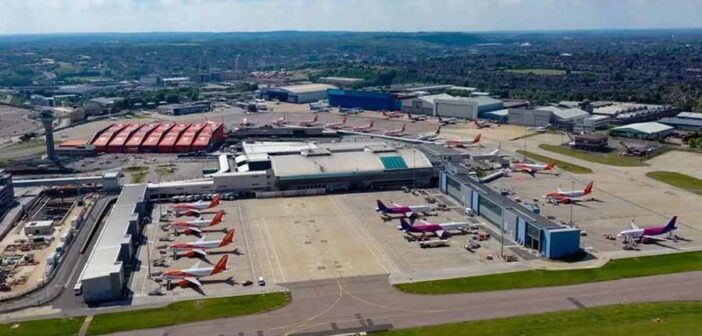London Luton Airport, located 45 kilometres north of central London in Bedfordshire, offers a practical and efficient experience for travellers. Handling over 16 million passengers annually, it ranks as England’s fifth-busiest airport, serving as a hub for low-cost carriers like easyJet, Ryanair, Wizz Air, and TUI Airways, with flights to over 145 destinations across Europe, North Africa, and the Middle East. Its accessibility and streamlined operations make it a solid choice for budget-conscious travellers.
Accessing the airport is straightforward, with multiple transport options connecting it to central London and beyond. The Luton Airport Express, combined with the Luton DART shuttle, provides a fast 32-minute journey from London St Pancras International to the terminal via Luton Airport Parkway station, with train fares starting at £10. Thameslink trains offer additional routes to Blackfriars and Farringdon, taking as little as 24 minutes with contactless payment accepted. National Express and Green Line coaches run frequent services to Victoria Coach Station, taking around 70 minutes for fares as low as £6.
Taxis or rideshare services like Uber cost approximately £80 to £100 from central London, while drivers can reach the airport via the M1 or M25, with short-stay, mid-stay, and long-stay parking options available. A free 30-minute drop-off zone in the Mid Stay Car Park is accessible via a free shuttle, though the Priority Drop Off Zone near the terminal charges £2.50 for 10 minutes.
The airport’s single, two-storey terminal is designed for ease of navigation. The ground floor houses 62 check-in desks, security screening, and arrivals facilities, while the upper floor features a departure lounge with 40 gates across three piers, numbered 1-19, 20-28, and 30-43. Zones A, B, C, and D cater to specific airlines, with easyJet in Zone C, Ryanair in Zone B, and Wizz Air in Zone D. The layout is compact, with clear signage and a central security area, ensuring most passengers clear security in under 15 minutes thanks to advanced scanners. However, peak hours, particularly early mornings or holiday periods, can lead to crowded queues due to high passenger volumes or understaffing, with some travellers reporting disorderly lines and slow self-service kiosks. Fast Track security, available from £4 online, helps bypass delays. Arriving two hours early for short-haul flights and three hours for long-haul is recommended.
Dining and retail options cater to a range of needs, though the selection is modest compared to larger airports. Airside, passengers can enjoy quick bites at Pret A Manger, coffee at Costa, or American-style meals at Sanfords, a two-floor diner with a mezzanine Loft Bar serving drinks and handheld food. The Big Smoke Taphouse & Kitchen offers pub fare, while M&S Simply Food provides grab-and-go snacks. Retail includes duty-free shops from Aelia, stocking cosmetics and alcohol, alongside Boots, WHSmith, and Accessorize for essentials and gifts. Prices are often higher than in the city, so budget travellers may prefer to shop beforehand. A Reserve and Collect service offers discounts on select items.
Facilities are practical and traveller-focused, with unlimited free Wi-Fi via the “Luton Airport WIFI” network and charging points near Gates 6, 7, 22, and 30, as well as in cafes. Family amenities include a children’s play area near Gate 7 and baby-changing facilities. Accessibility is prioritised, with a Changing Places facility near Gate 17, wheelchair assistance, and a new airside Assisted Travel lounge opening in June 2025, featuring sensory spaces and charging points. The Aspire Lounge and Clubrooms, available from £24, offer snacks, drinks, and showers, though food variety can be limited. A Quiet Room by Gate 17 provides a calm space, though it’s not guaranteed to be silent. Currency exchanges, ATMs, and a multi-faith prayer room are available, but seating can be scarce during peak times, with some passengers reporting difficulty finding spots.
On-time performance is generally strong, with easyJet operating 21,208 flights in 2023, experiencing only 302 cancellations and 111 delays. However, disruptions can occur due to weather, particularly fog or snow, given the airport’s location, or air traffic control issues across Europe. Airline-specific problems, like technical faults or tight turnaround schedules for low-cost carriers, can also cause delays. Passengers are advised to monitor flight statuses via in-terminal displays, the airport’s LIVE flight checker, or apps like Flightradar24.
Connections at Luton are limited, as the airport lacks dedicated transit facilities for international passengers. Those connecting must pass through immigration, collect luggage, and recheck-in, requiring at least two hours between flights. Minimum connection times are 30 minutes for domestic-to-domestic, 60 minutes for domestic-to-international, and 90 minutes for international-to-international transfers. The single-terminal layout simplifies navigation, but the lack of direct transit means travellers should plan ample layover time, especially with budget airlines that may not assist with missed connections.
Potential delays often stem from weather disruptions, air traffic control shortages, or operational issues like baggage handling or gate availability during peak hours. Congestion at check-in or security can also slow the process, particularly when low-cost carriers overbook slots or understaff desks. Travellers should check gate assignments early and avoid third-party services like My Trip Online, which have been linked to unauthorised subscription charges.




